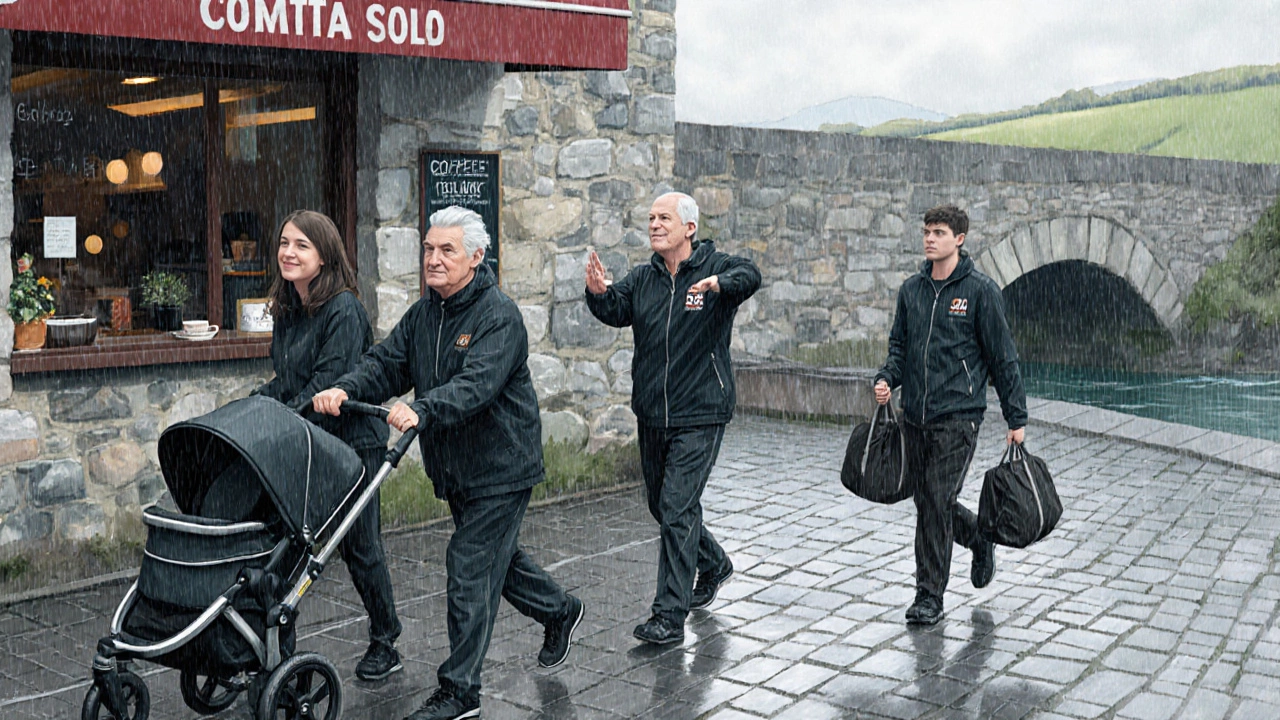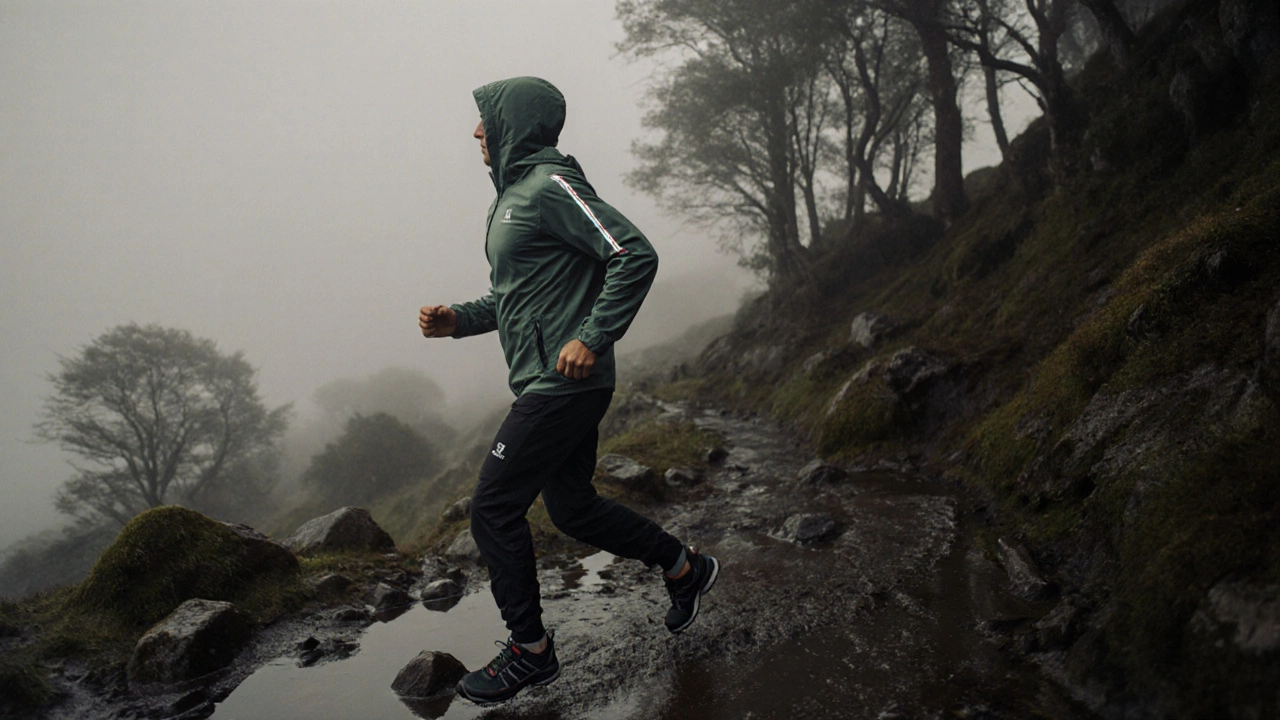In Ireland, sportswear isn’t just about looking fit-it’s about surviving the weather, moving through the landscape, and fitting into a culture that values practicality over flash. Whether you’re jogging along the DART line in Dublin, hiking the Wicklow Way, or hitting the weights at a local gym in Cork, what you wear has to handle rain, wind, and sudden temperature drops. So what exactly counts as sportswear here? It’s not just leggings and branded tees. It’s gear that works in a climate where summer can feel like a bonus, and autumn never really leaves.
It’s Not Just the Gym-It’s the Whole Landscape
In Ireland, sportswear doesn’t start and end at the gym door. You’ll see people wearing the same moisture-wicking hoodie and waterproof joggers from a morning trail run in Glendalough straight to the coffee shop in Galway. That’s because the line between athletic wear and everyday wear is thin here. You don’t need to change after a 5K around Phoenix Park-you just dry off, grab a hot chocolate, and keep going.
Brands like Irish Outdoor and Clare Valley Active have built their reputation on this blend. Their products are designed for the Irish environment: seams sealed against drizzle, hoods that stay put in 40mph winds, and fabrics that dry fast even when hung on a radiator in a damp apartment in Limerick. You won’t find many locals wearing shiny, neon running tights that scream ‘fitness influencer’-unless they’re actually training for a race. Most prefer muted greens, greys, and navy tones that don’t show mud, rain streaks, or dried seawater from a coastal walk in Donegal.
What Makes Sportswear ‘Irish’?
Irish sportswear has three non-negotiable features: water resistance, breathability, and durability. A standard pair of running leggings from a global brand might work fine in dry climates, but here? They’ll soak through after 15 minutes in a downpour. That’s why brands like Patagonia, Salomon, and Decathlon’s Kalenji line are common in Irish wardrobes-they’re tested in real conditions, not just on treadmill videos.
Even the materials matter. You’ll notice a lot of Irish athletes and walkers prefer merino wool blends over pure synthetics. Why? Wool naturally regulates temperature, resists odor (important if you’re running three times a week in the same pair of shoes), and still dries quickly. Companies like Smartwool and Icebreaker have seen a steady rise in sales across Irish outdoor retailers like Mountain Equipment in Belfast and Go Outdoors in Limerick.
And then there’s the footwear. Trail runners with Vibram soles are the default here. You don’t need expensive hiking boots unless you’re climbing Croagh Patrick. For most, a pair of Salomon Speedcross or Merrell Moab does the job-gripping wet rocks at the Cliffs of Moher, navigating muddy fields near the Burren, or handling puddle-filled pavements in Cork city center.
It’s Not Just for Athletes-It’s for Everyone
Irish sportswear isn’t reserved for elite runners or CrossFit warriors. It’s worn by parents pushing strollers through Merrion Square, teachers walking to school in Bray, retirees doing tai chi by the River Liffey, and students heading to the gym after lectures at Trinity College. The rise of ‘athleisure’ here isn’t about fashion-it’s about function.
Look around any Irish town on a Saturday morning. You’ll see people in Tracksmith shorts, Adidas Climacool tops, and Under Armour base layers-not because they’re trying to look cool, but because their gear keeps them dry and warm during a 7 a.m. walk in the rain. Even the local yoga studio in Kilkenny doesn’t require special yoga pants. A pair of stretchy, dark leggings and a long-sleeve top will do just fine.
What’s more, the Irish don’t buy sportswear for logos. You won’t see many people wearing oversized Nike swooshes or Adidas stripes unless they’re actually playing for a team. Instead, you’ll find subtle branding-small embroidered logos on sleeves, discreet tags on the waistband. It’s a quiet kind of practicality that fits with Irish values: get the job done, don’t make a show of it.

The Role of Local Events and Community
Irish sportswear culture is shaped by local events. The Galway International Oyster Festival might be about seafood, but the runners who line the streets for the Galway Marathon wear gear that can handle Atlantic winds. The Wicklow Way Challenge doesn’t care if your leggings are from a big brand or a discount store-only if they’ll keep you moving through boggy terrain.
Community clubs play a big role too. Local running groups like Dublin Running Club, Sligo Runners, or Waterford Athletic Club often organize bulk buys of sportswear from Irish suppliers. These aren’t flashy sponsorships-they’re practical partnerships. You’ll see members wearing matching vests from Irish Running Gear, a small Cork-based company that makes reflective vests and windbreakers designed for Ireland’s unpredictable light and weather.
What Doesn’t Count as Sportswear Here?
Just because something looks athletic doesn’t mean it’s fit for Ireland. Thin cotton T-shirts? They’ll cling and chill you to the bone. Flimsy sneakers with no grip? You’ll slip on a wet cobbled street in Kilkenny. Oversized hoodies that don’t have a drawstring? They’ll fly off in a gust near the Giant’s Causeway.
And forget the all-white running gear. It’s a fashion statement elsewhere-but here, it’s a nightmare. You’ll be lucky to keep it clean for a week. Dark colors, quick-dry fabrics, and reinforced seams? That’s the Irish uniform.

Buying Sportswear in Ireland: What to Look For
If you’re shopping locally, here’s what to check:
- Water resistance: Look for DWR (durable water repellent) coating, not just ‘water-resistant’ labels.
- Wind protection: A hood that stays on your head during a gale is worth its weight in gold.
- Moisture-wicking: Avoid 100% cotton. Look for polyester, nylon, or merino blends.
- Reflective details: With shorter daylight hours from October to March, visibility matters.
- Flatlock seams: These prevent chafing during long walks or runs on uneven ground.
Local stores like Go Outdoors, Mountain Equipment, and Decathlon in Dublin and Cork have dedicated sections for Irish conditions. You’ll also find smaller shops like Active Ireland in Galway and Trail & Tread in Ennis that stock gear tested on the Wild Atlantic Way.
Final Thought: Sportswear as a Way of Life
In Ireland, sportswear isn’t a trend. It’s a necessity shaped by geography, climate, and culture. It’s the gear that lets you keep moving-whether you’re chasing a bus in Belfast, walking the Ring of Kerry, or just getting through the week without catching a cold. You don’t need the most expensive brand. You just need something that won’t let you down when the rain comes, as it always does.
So if you’re wondering what counts as sportswear here-it’s anything that keeps you warm, dry, and moving, no matter what the sky throws at you.
Is cotton considered sportswear in Ireland?
No, pure cotton is not considered suitable sportswear in Ireland. It absorbs moisture and takes hours to dry, which can lead to chills and discomfort in our damp, changeable climate. Even light cotton T-shirts can become heavy and cold after a short walk in the rain. For outdoor activity, always choose moisture-wicking fabrics like polyester, nylon, or merino wool blends.
Can I wear regular sneakers for hiking in Ireland?
Not for serious hiking. Regular sneakers lack the grip and ankle support needed for Ireland’s muddy trails, rocky paths, and wet stone steps. Trail runners with Vibram soles-like Salomon Speedcross or Merrell Moab-are the standard for anything beyond a paved park path. Even a light hike on the Wicklow Way requires proper traction to avoid slips on moss-covered rocks.
What’s the best brand for Irish weather?
There’s no single ‘best’ brand, but Patagonia, Salomon, and Decathlon’s Kalenji line are consistently reliable for Irish conditions. Local brands like Irish Outdoor and Irish Running Gear are also highly trusted because they design specifically for wind, rain, and frequent temperature shifts. Look for gear with sealed seams, adjustable hoods, and DWR coatings.
Do I need different sportswear for winter vs. summer in Ireland?
Yes, but not drastically. The real difference is layering. In summer, a lightweight moisture-wicking top and shorts suffice. In winter, you’ll want a thermal base layer, a windproof mid-layer, and a water-resistant outer shell. Many Irish athletes wear the same leggings year-round-they just add or remove layers on top. The key is versatility, not seasonal wardrobes.
Are there any Irish-made sportswear brands?
Yes. Brands like Irish Outdoor (based in Cork), Irish Running Gear (Galway), and Clare Valley Active (County Clare) design and manufacture sportswear specifically for Irish conditions. They focus on durability, weather resistance, and practical features like reflective strips and reinforced knees. Supporting these brands means getting gear built for the local climate, not imported from dry climates.
